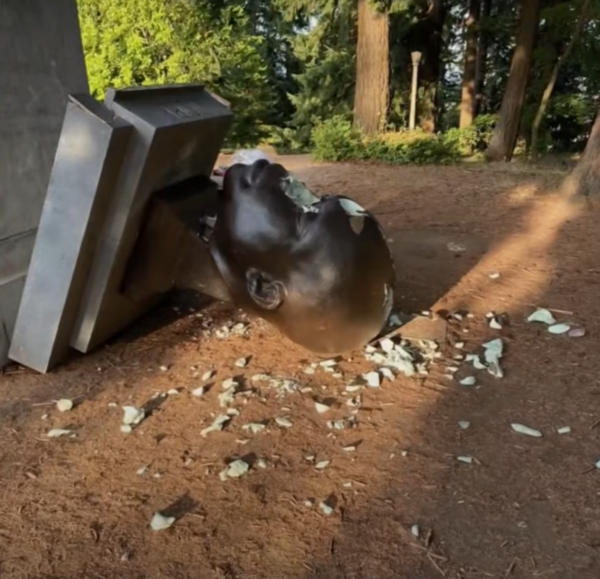The bust of the only Black man who traveled across North America with the Lewis & Clark Expedition was toppled from its position atop Mount Tabor in a Portland, Oregon, park sometime on the night of July 27 or in the early morning hours of July 28.
The bust of York, an enslaved Black man belonging to William Clark, was anonymously installed by an artist in February, along with a plaque describing him as “The first African American to cross North America and reach the Pacific Coast.”

Photos show the bust on the ground, its nose torn off and the forehead shattered. The plaque that described York’s role in the expedition was also torn apart. A park worker was notified of the statue’s destruction by a visitor on Wednesday.
The bust of York had taken the place of the statue of The Oregonian journalist Harvey Scott, which was toppled in October after standing for 87 years.
A spokesman for Portland Parks & Recreation told the Willamette Week the bust has now been removed and the site has been cleaned. Staff will see if it can be salvaged. It had been seen intact by a passerby on the evening on July 27.
“Unfortunately, the numerous racist responses to the memorial of a Black man forced to participate in the Corps of Discovery Expedition have not been a surprise,” Portland Parks and Recreation Director Adena Long said. “The latest act of vandalism is incredibly disappointing for me, and I’m sure the majority of Portlanders will miss seeing York at the top of Mt. Tabor.”

Between May 14, 1804, and Sept. 23, 1806, Meriwether Lewis and William Clark took part in an expedition after President Thomas Jefferson asked Lewis to explore the lands west of the Mississippi River that comprised the Louisiana Purchase. Lewis selected Clark as his co-leader.
While York, born sometime between 1770 and 1775, was compelled to embark on the travels by his owner, his role in the expedition was equal to that of the white men, according to Smithsonian Magazine. He carried a gun and regularly hunted buffalo, deer, and geese to feed the party during the 28-month journey.
Although it has only been on display for a matter of months, the statue has been defaced before. In June, a woman was filmed spray-painting the bust and could be heard yelling about the fact that a bust of a Black man had replaced a white man.
“It’s love and unity, not to replace a white man with a f—ing Black man. That’s not f—ing unity,” she said, cursing throughout in a 54-second video shared on Twitter. Police charged her with several misdemeanors and the paint was later removed.
In two other cases, someone defaced the statue, demanding the land be returned to Native Americans, and on another occasion, someone vandalized the bust with a white supremacist symbol used by Patriot Front. It is not yet clear who defaced the statues in the most recent act of vandalism or what ideology motivated the act.
The statue is made of wood and urethane painted bronze and is unlikely to survive the elements over a long period. The city had discussed the possibility of replacing the statue with a more durable version, but so far there aren’t any plans to replace the bust.


